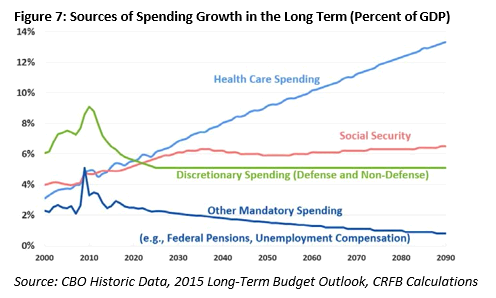Is the Health Care Cost Problem Solved?
The U.S. has been experiencing very low health care cost growth by historical standards since 2009, and projec- tions of federal health care spending have also fallen significantly. However suggesting that the health care cost issue is solved would be disingenuous.
For starters, it is likely that a significant share of the slowdown is temporary – due to a combination of legislative, demographic, economic, and idiosyncratic causes that range from one-time Medicare spending cuts to a “patent cliff” in drug prices. In addition, the aspects of the slowdown which are permanent are highly uncertain, and even CBO could only explain about one quarter of the slowdown’s cause.
While the slowdown in per capita health care costs is uncertain, the aging of the population is quite certain over the next quarter-century. CBO expects aging to be responsible for over half of the spending growth in the major entitlement programs (excluding the impact of the implementation of the ACA).
Already, federal health care spending totals 5.2 percent of GDP, more than we spend on Social Security or defense. CBO projects those costs to grow to 8 percent of GDP by 2040 and over 13 percent by 2090. At that point, the federal government will be spending more on health care than the entire rest of governmentcombined.
Ruling: Largely False


